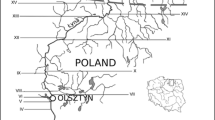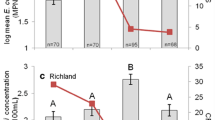Abstract
The United States Environmental Protection Agency (USEPA) recommends the use of Escherichia coli (E. coli) and enterococci as indicators of enteric pathogens in fresh waters; however, fecal coliform analyses will remain important by virtue of the large amount of historic data collected in prior years. In this study, we attempted, in a real-world situation (i.e., a rural inland watershed in the Piedmont of South Carolina) to compare different bacterial indicators and methods to one another. We compared fecal coliforms, enumerated by membrane filtration with E. coli, enumerated by a commercialized enzyme substrate method and observed E. coli/fecal coliform ratios of 1.63 and 1.2 for two separate tests. In the same watershed, we observed an E. coli/fecal coliform ratio of 0.84 when we used the commercialized enzyme substrate method for both enumerations. Given these results, users of such data should exercise care when they make comparisons between historic membrane filtration data and data acquired through the use of the more modern enzymatic methods. Some sampling and side-by-side testing between methods in a specific watershed may be prudent before any conversion factors between old and new datasets are applied.
Similar content being viewed by others
References
American Public Health Association, American Water Works Association, Water Environment Federation, Standard Methods for the Examination of Water and Wastewater (1995) 18th ed., Eaton, A. D., Clesceri, L. S., and Greenberg, A. E. (eds.), Washington, D.C.
Brenner, K. P. and Rankin, C. C.: 1990, ‘New screening test to determine the acceptability of 0.45-μm membrane filters for analysis of water’, Appl. Environ. Microb. 56, 54–64.
Budnick, G. E., Howard, R. T. and Mayo, D. R.: 1996, ‘Evaluation of enterolert for enumeration of enterococci in recreational waters’, Appl. Environ. Microb. 62, 3881.
Cabelli, V. J.: 1983, ‘Water-borne Viral Infections’, in: M. Butler, A. R. Medlen and R. Morris (eds), Viruses and Disinfection of Water and Wastewater, Surrey Press, Guilford, England, pp. 107-130.
Chao, K., Chao, C. and Chao,W.: 2004, ‘Evaluation of Colilert 18 for detection of coliforms and Escherichia Coli in Subtropical Freshwater’, Appl. Environ. Microb. 70, 1242–1244.
De Roubin, Osswald, M. L., Bally, D., Cailas, M., and Joret, J. C.: 1997, ‘Comparison of field and standardized techniques for the enumeration of total coliforms and Escherichia coli in water’, in: Proceedings of AWWA-Water Quality Technology Conference, November 7–11, 1997, Denver, CO.
Eckner, K. F.: 1998, ‘Comparison of membrane filtration and multiple-tube fermentation by the Colilert and Enterolert methods for detection of waterborne coliform bacteria, Escherichia coli, and enterococci used in drinking and bathing water quality monitoring in southern Sweden’, Appl. Environ. Microb. 64, 3079–3083.
Francy, D. S. and Darner, R. A.: 2000, ‘Comparison of methods for determining Escherichia coli concentrations in recreational waters’, Water Res. 34, 2770–2778.
Fricker, E. J., Illingworth, K. S. and Fricker, C. R.: 1997, ‘Use of two formulations of Colilert and Quantitray for assessment of the bacteriological quality of water’, Water Res. 31, 2495–2499.
Geissler, K., Manafi, M., Amoros, I. and Alonso, J. L.: 2000, ‘Quantitative determination of coliforms and Escherichia coli in marine waters with chromogenic and fluorogenic media’, J. Appl. Microbiol. 88, 280–285.
Jacobs, N. J., Ziegler, W. L., Reed, F. C., Stuckel, T. A. and Rice, E. W.: 1986, ‘Comparison of membrane filter, multiple-fermentation-tube, and presence-absence techniques for detecting total coliforms in small community water systems’, Appl. Environ. Microb. 51, 1007–1012.
Leclerc, H., Mossel, D. A., Edberg, S. C. and Struijk, C. B.: 2001, ‘Advances in the bacteriology of the coliform group: their suitability as markers of microbial water safety’, Annu. Rev. Microbiol. 55, 201–234.
Mallin, M., Williams, K. E., Cartier Esham, E. and Lowe, R. P.: 2000, ‘Effect of human development on bacteriological water quality in coastal watersheds’, Ecol. Appl. 10, 1047–1056.
McFeters, G. A., Pickett, M., Broadaway, S. C. and Pyle, B. H.: 1997a, ‘Impact of chlorine injury on reaction kinetics of coliforms and E. coli in Colisure and LTB’, Water Sci. Technol. 35, 419-422.
McFeters, G. A., Broadaway, S. C., Pyle, Pickett, B. H. and Egozy, Y.: 1997b, ‘Comparative performance of Colisure’, J. Amer. Wastewater Assn. 89, 112– 120.
Miller A.: 2001, ‘Total maximum daily load development for Bush River: Stations S-046 and S-102 Fecal Coliform Bacteria’, Technical Report, Bureau of Water, South Carolina Department of Health and Environmental Control, Columbia, SC. http://www.scdhec.gov/water/html/tmdlsc.html (accessed Sept 25, 2004).
MinitabTM Statistical Software. Release 13 for Windows®, MinitabTM, State College, PA. 2000.
Neimi, R. M., Heikella, M. P., Lahti, K., Kalso, S. and Niemela, S. I.: 2001, ‘Comparison of methods for determining the numbers and species distribution of coliform bacteria in well water samples’, J. Appl. Microbiol. 90, 850–858.
Niemela, S. I., Lee, J. V. and Fricker, C. R.: 2003, ‘A comparison of the International Standards Organisation reference method for the detection of coliforms and Escherichia coli in water with a defined substrate procedure’, J. Appl. Microbiol. 95, 1285–1292.
Noble, R. T., Leecaster, M. K., McGee, C. D., Weisberg, S. B. and Ritter, K.: 2004, ‘Comparison of bacterial indicator analysis methods in stormwater-affected coastal waters’, Water Res. 38, 1183–1188.
Noble, R. T., Weisberg, S. B., Leecaster, M. K., McGee, C. D., Dorsey, J. H., Vainik, P. M. and Orozco-Borbion, V.: 2003, ‘Storm effects on regional beach water quality along the southern California shoreline’, J. Water Health, 1, 23–31.
Ø stensvik, Ø .: 2000, ‘Coliform bacteria and Escherichia coli in Norwegian drinking water sources – Comparison of methods based on the fermentation of lactose and on the activity of specific enzymes’, in: Proc. AWWA Water Quality Technology Conference, November, 5–8, 2000, Salt Lake City, Utah.
Pisciotta, J. M., Rath, Stanek, P. A., Flanery, D. M. and Harwood, V. J., 2002, ‘Marine bacteria cause false-positive results in the colilert-18 rapid identification test for Escherichia coli’, Appl. Environ. Microb. 68, 539–544.
Rompré, A., Servais, P., Baudart, J., de-Roubin, M. and Laurent, P.: 2002, ‘Detection and enumeration of coliforms in drinking water: current methods and emerging approaches’, J Microbiol. Meth. 49, 31–54.
SAS Institute Inc.: 2000, SAS OnlineDoc, Version 8, Cary, NC.
Schumacher, J. G.: 2003, ‘Survival, Transport, and Sources of Fecal Bacteria in Streams and Survival in Land-Applied Poultry Litter in the Upper Shoal Creek Basin, Southwestern Missouri, 2001–2002’, Technical Report, USGS Water-Resources Investigations Report 03–4243, Rolla MO. Available at: http://mo.water.usgs.gov/Reports/wrir03-4243-schu/, October 26, 2004.
Shibata, T. Solo-Gabriele, H. M., Fleming, L. E. and Elmir, S.: 2004, ‘Monitoring marine recreational water quality using multiple microbial indicators in an urban tropical environment’, Water Res. 38, 3119–3131.
Smith, E. P. and Rose, K. A.: 1995, ‘Model goodness-of fit analysis using regression and related techniques’, Ecol. Model. 77, 49–64.
South Carolina Department of Health and Environmental Control: 2001, ‘Water Classifications and Standards (R.61–68)’, Columbia, SC. Available at: http://www.scdhec.net/eqc/water/html/ reg.html, October 29, 2004.
United States Environmental Protection Agency (USEPA): 1986, ‘Ambient Water Quality Criteria for Bacteria–1986’, U.S. Environmental Protection Agency. EPA-440/5-84-002., Washington DC: Office of Water.
United States Environmental Protection Agency (USEPA): 2002, ‘Draft Implementation Guidance for Ambient Water Quality Criteria for Bacteria’, U.S. Environmental Protection Agency. EPA-823-B-02-003, Washington DC: Office of Water.
Vernberg, W. B., Scott, G. I., Strozier, S. H., Bemiss, J., Daugomah, J. W.: 1996, ‘The effects of urbanization on human and ecosystem health’, in: F. J. Vernberg, W. B. Vernberg, T. Siewicki (eds.), Sustainable Development in the Southeastern Coastal Zone, University of South Carolina Press, Columbia, SC, pp. 221–239.
Yakub, G. P., Castric, D. A., Stadterman-Knauer, D. L., Tobin, M. J., Blazina, M., Heineman, T. N., Lee, G. Y. and Frazier, L.: 2002, ‘Evaluation of Colilert and Enterolert Defined Substrate Methodology for Wastewater Applications’, Water Environ. Res. 74, 131–135.
Author information
Authors and Affiliations
Corresponding author
Rights and permissions
About this article
Cite this article
Kloot, R.W., Radakovich, B., Huang, X. et al. A Comparison of Bacterial Indicators and Methods in Rural Surface Waters. Environ Monit Assess 121, 275–287 (2006). https://doi.org/10.1007/s10661-005-9121-5
Received:
Accepted:
Published:
Issue Date:
DOI: https://doi.org/10.1007/s10661-005-9121-5




